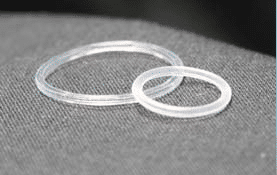4 ways to lower the friction of silicone and avoid blocking
Silicone has high surface friction and tends to stick to itself. Here we give you four options on how to lower the friction of silicone.
Silicone has high surface friction and tends to stick to itself. Here we give you four options on how to lower the friction of silicone.

Silicone generally has a high coefficient of friction and is inherently tacky. The softer the silicone, the tackier it will be. This means that silicone will tend to pick up dust, easily sticks to itself and other materials and has a high coefficient of friction. When silicone sticks to itself, it is usually called blocking. These properties can become problematic in applications requiring a silicone component that will need to be able to move or slide. Here are 4 ways to lower the friction of silicone, to avoid dust pick-up and blocking:
A nice and long-term way to lower the friction of your silicone, for example to reduce insertion force or drag force, is to apply a curable coating on the silicone elastomer. Coatings that lower the coefficient of frictions (CoF) are available from Nusil. These coating formulations are solvent based, so your process must tolerate the use of solvents. When cured, the coating is completely dry and non-migrating.
A low CoF coating will decrease the static coefficicient of friction by up to 74 % and the kinetic coefficient of friction by up to 54 % on a typical LSR. In addition, the coating will increase the resistance to abrasion.
There are two types of curing mechanisms available for the coatings: platinum catalyzed for platinum catalyzed rubbers (like most LSRs and HCRs) or moisture curable for Tin-containing silicones.

A silicone fluid can help minimize the break loose force and reduce the insertion force and drag force. When choosing a silicone fluid as a lubricant, it is important to choose one with low chemical affinity to the silicone rubber. If a regular silicone oil is used on regular silicone (PDMS), the fluid will migrate into the elastomer, making it swell, and of course, lose its lubricating properties. Instead, choose a fluorosilicone based lubricant and vice versa.
The silicone fluid can be applied to your silicone part as-is or be dispersed in a solvent for a thinner and more even application. Consider the viscosity when choosing your fluid. A higher viscosity will migrate more slowly.
A silicone grease will also minimize the break loose force. The advantage of choosing a grease over a fluid is that the higher viscosity makes it migrate less which in turn, will lubricate your silicone rubber for longer.
As for silicone fluids, a silicone grease should be chosen with the silicone chemistry in mind. A fluorosilicone grease should be used for regular silicone and a regular fluid for fluorosilicone, respectively. The grease can be applied as-is or dispersed in solvent.
To reduce processing time and avoid adding extra manufacturing steps for lubrication, using a self-lubricating silicone for your molded parts can be an option. This technology means that your LSR or HCR already is loaded with lubricant. This lubricant will, after vulcanisation of the silicone elastomer, migrate out to the surface in an even pace. The silicone as well as the amount of lubricant can be adapted.
Contact us to discuss your specific application and get advice on which product to choose!

Removing a cured adhesive can be tricky and the type will determine the method. The main methods are heat, chemicals and mechanical force.
Read more
When choosing an adhesive for your application, it is advantageous if you consider the adhesive viscosity to best suit your application and process.
Read more
Medical grade adhesives are commonly biocompatibility tested according to ISO 10993 standard. Choose Epoxy, UV-curing adhesive or silicone.
Read more
Electrically conductive adhesives are used in many different types of industries and applications. Some examples are electronics, solar cell, medical, aerospace, space and automotive applications.
Read more
Silicone rubber is one of the most difficult-to-bond rubbers. We will give you options for adhesives that can help you bond silicone.
Read more